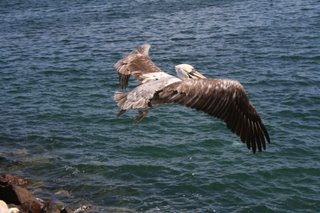
Prawns into Europe
Meeting on tuesday with Matt Hopkinson, manager of the Guayaquil branch of 'Inspectorate' and the Latin American technical manager, Leonardo Mariduena gave me a useful overview of the regulations existing for the importation of prawns from Ecuador (and other Latin American producing nations) to the European Union. Inspectorate test outgoing batches for a range of contaminants and residues and are as such a quality regulator of products for foreign markets (with acceptable limits set in this case by the EU). Inspectorate are a subsidiary commercial company set up by the British Standards Institute (BSI).
Next day I was invited to meet the Dean (Enrique Sanchez Cuadros) of Maritime Engineering and Marine Sciences Faculty at the Escuela Superior Poltecnica del Littoral (ESPOL) at their Guayaquil campus. Remember that ESPOL have their associated marine outstation linked to CENAIM (visited earlier in the week), with several of the postdocs and students based at the Guayaquil campus. I had an interesting discussion with the Dean about a proposed upcoming World Bank project on conservation of the Ecuador and Galapagos coastline and it appears that ESPOL and Cefas have a number of common interests (not least a developing requirement for biological effects monitoring using fish and mollucs). Dr Paola Calle, a postdoc at ESPOL hs recently one a grant to develop molluscs as markers for contamination...starting on the River Guayas running through central Guayaquil. From here, we discussed the possibilities of expanding this type of study to coastal regions, fish and potentially to the supposed pristine 'reference' of the Galapagos Islands themselves (though a worrying expansion in tourism and habitation of the islands may preclude this). Paola and I will discuss these ideas further over coming weeks (I guess we would have no shortage of Cefas volunteers for field work in Galapagos?!).
Another useful contact at ESPOL was Sonya Mendoza who runs CSA (Centre for Services to Aquaculture). This laboratory was established using EU funding a number of years back and was designed to provide services to the Aquaculture industry of Ecuador, particularly for disease diagnostics and advice on prevention and treatment.
Yesterday ended with a nice evening stroll along the Malecon and into the once notorious slum Las Penas. This area has been completely renovated over recent years, driven by the Mayor of Guayaquil. This once dangerous region now supports a range of small business (cafes, artists, bars etc) and is overlooked by a new lighthouse which when climbed gives a great view of the city. As seems typical of the city, the region is enclosed by high walls, security gates and armed guards who protect the naive tourist from the 'real' city that lies beyond the barrier but talking to my local hosts and guides Claudia, Gustavo and Anna, the recent improvements are being well recieved by all, who feel that Guayaquil is a city on the up. The Mayor is now extending his ideas into other parts of the city.
Ok, so it's the weekend and I am quite excited since I am going to be given a surfing lesson by Gustavo Plaza Iturralde, editor of the Latin American surf magazine 'Radical'. Gustavo is taking me to the best 'break' in Ecuador at a place called Montanita. If I survive the sharks (Joke mum...there has never been a shark attack in Ecuador...on a local) then on Sunday I am going to take a boat ride to Isla de la Plata (or 'Poor Man's Galapagos) out from Montanita where I will hopefully come into contact with the Blue Footed Booby and the Albatross, plus some Iguana. I will post some pics on monday. Ciao.

0 Comments:
Post a Comment
<< Home